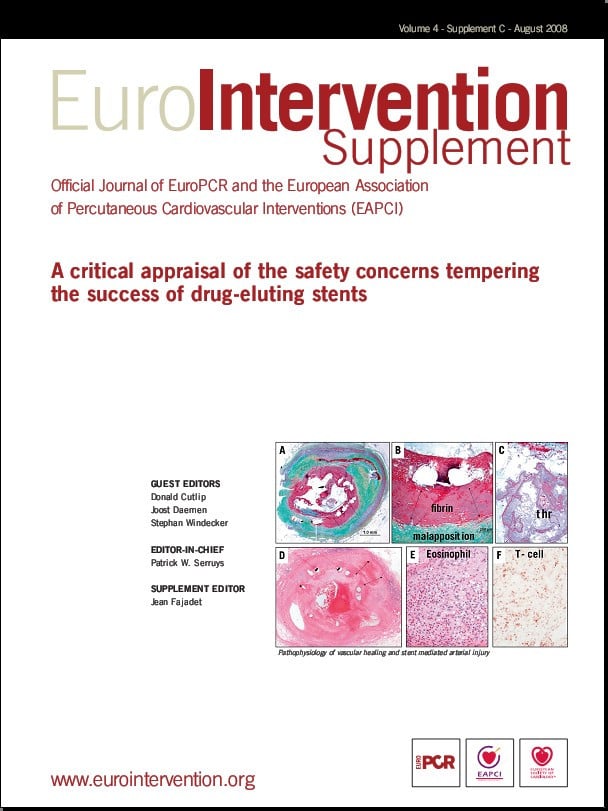Abstract from the New York registry
Abstract
Background: Numerous studies have compared the outcomes of two competing interventions for multivessel coronary artery disease: coronary-artery bypass grafting (CABG) and coronary stenting. However, little information has become available since the introduction of drug-eluting stents.
Methods: We identified patients with multivessel disease who received drug-eluting stents or underwent CABG in New York State between October 1, 2003, and December 31, 2004, and we compared adverse outcomes (death, death or myocardial infarction, or repeat revascularisation) through December 31, 2005, after adjustment for differences in baseline risk factors among the patients.
Results: In comparison with treatment with a drug-eluting stent, CABG was associated with lower 18-month rates of death and of death or myocardial infarction both for patients with three-vessel disease and for patients with two-vessel disease. Among patients with three-vessel disease who underwent CABG, as compared with those who received a stent, the adjusted hazard ratio for death was 0.80 (95% confidence interval [CI], 0.65 to 0.97) and the adjusted survival rate was 94.0% versus 92.7% (P = 0.03); the adjusted hazard ratio for death or myocardial infarction was 0.75 (95% CI, 0.63 to 0.89) and the adjusted rate of survival free from myocardial infarction was 92.1% versus 89.7% (P<0.001). Among patients with two-vessel disease who underwent CABG, as compared with those who received a stent, the adjusted hazard ratio for death was 0.71 (95% CI, 0.57 to 0.89) and the adjusted survival rate was 96.0% versus 94.6% (P = 0.003); the adjusted hazard ratio for death or myocardial infarction was 0.71 (95% CI, 0.59 to 0.87) and the adjusted rate of survival free from myocardial infarction was 94.5% versus 92.5% (P<0.001). Patients undergoing CABG also had lower rates of repeat revascularisation.
Conclusions: For patients with multivessel disease, CABG continues to be associated with lower mortality rates than does treatment with drug-eluting stents and is also associated with lower rates of death or myocardial infarction and repeat revascularisation.
N Engl J Med. 2008 Jan 24;358(4):331-41. Copyright © 2008 Massachusetts Medical Society. All rights reserved.
Acknowledgement
Reprinted from The New England Journal of Medicine, Volume 358:331 January 24, 2008 Number 04, with permission from Massachusetts Medical Society.
Commentary on the New York registry
Comparisons between coronary artery bypass surgery (CABG) and percutaneous coronary intervention (PCI) in patients with multivessel disease is most certainly one of the most controversial and impassioned issues in contemporary cardiology. Several randomised trials performed in the 80 and 90’s repeatedly showed less repeat revascularisations after CABG1. Analysis of the diabetic subgroup from the BARI trial showed a higher mortality after PCI2. As a consequence, CABG remains the gold (or even platinum) standard in the treatment of multivessel disease in current guidelines. However, since the advent of drug eluting stents (DES), an increasing number of patients with mutlivessel disease are treated with PCI. Despite the obvious rationale of using a technique which has proven its efficacy in reducing the need for repeat revascularisation, there is currently limited data to support this practice. The ARTS II study compared a registry of contemporary patients treated with DES to patients included in the ARTS I randomised study comparing CABG and PCI with bare metal stents3. Outcome at one year showed highly favorable results in the DES patients. However, the conclusions are limited by the small amount of patients included.
Hannan et al used a registry from the New York state and identified patients with multivessel disease who received DES or underwent CABG in New York State between October 1, 2003, and December 31, 20044. After adjustment for differences in baseline risk factors by propensity analysis, they compared adverse outcomes (death, death or myocardial infarction, or repeat revascularisation) through December 31, 2005. In comparison with PCI with DES, CABG was associated with lower adjusted18-month rates of death and of death or myocardial infarction both for patients with three-vessel disease and for patients with two-vessel disease. Repeat revascularisation was lower after CABG in all groups.
Are we on a dangerous path when we choose PCI with DES for treatment of multivessel disease? Hannan et al should be commended for performing an elaborate analysis on a large registry study. To compensate for the lack of randomisation and differences in baseline characteristics, the authors attempted to equalize the two groups by using propensity analysis. However, no statistical technique can adjust for the judgment of the treating physician which remains the most important factor leading to the choice of revascularisation technique. In fact, a major finding of the study was clearly overviewed by the authors: non-adjusted mortality rates were quite similar in both treatment groups, even in patients with diabetes. This clearly shows that patients were appropriately selected before treatment. Finally, although propensity analysis is valuable in assessing differences between groups, propensity-score matching might have been more appropriate5.
Several randomised trials comparing PCI with DES and CABG are ongoing. Their results will most certainly be the basis of our future decisions in patients with multivessel disease. Until then, adjusted data from registries will provide interesting insights on our practice and patient selection process.

